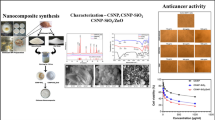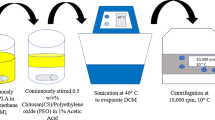Abstract
Background
3, 3′-Diindolylmethane (DIM) is a dietary indole compound; its medical application was limited because of poor bioavailability, unsatisfying dispersity, and rapid metabolism. To conquer this problem, nanoformulation of DIM was synthesized and investigated its mechanism-based chemotherapeutic potential.
Methods
7,12-Dimethylbenz(a)anthracene (DMBA) 25 mg/kg b.wt initiated mammary carcinogenesis in rats, the investigational tumor model that closely resembles human mammary cancer. Rats had accessed after 8 weeks of tumor formation, DIM 10 mg/kg b.wt. and DIM@CS-NP 0.5 mg/kg b.wt. were administrated orally for 8 weeks.
Results
The treatment with DIM@CS-NP 0.5 mg/kg b.wt. on DMBA-induced tumor-bearing rats was down-regulated Cyclin D1, Bcl-2 expression, and up-regulated proapoptotic proteins such as Bax, p53, Cytochrome-C, Caspase-9, and Caspase-3 as compared to DIM 10 mg/kg b.wt. In addition, the mRNA expressions of Cyclin D1, Bcl-2 decreased and increased Bax, p53 expression, in immunohistochemical analysis decreased expressions of Cyclin D1 and PCNA in the treatment of DIM@CS-NP 0.5 mg/kg b.wt. compared to DIM 10 mg/kg b.wt. Histological analysis of tumor tissues shows abnormal in collagen deposition in with Masson’s trichrome (MT) and Picrosirius red (PR) staining, the treatment of DIM@CS-NP 0.5 mg/kg b.wt. reduced the collagen deposition as compared to DIM 10 mg/kg b.wt.
Conclusion
Our results clearly provide evidence that DIM@CS-NP exerts chemotherapeutic effect than DIM in DMBA model of mammary cancer by hold back anomalous tumor cell proliferation and inducing apoptosis to intervene through alterations of up-regulated and down-regulated molecules. Taken together, the data provide new evidence for mechanism action of DIM@CS-NP on mammary cancer.






Similar content being viewed by others
Change history
30 September 2020
In the original publication of the article.
References
Maeda H, Wu J, Sawa T, Matsumura Y, Hori K. Tumor vascular permeability and the EPR effect in macromolecular therapeutics: a review. J Control Release. 2000;65:271–84.
Blanco E, Ferrari M. Emerging nanotherapeutic strategies in breast cancer. Breast. 2014;23:10–8.
Hu Y, Jiang X, Ding Y, Ge H, Yuan Y, Yang C. Synthesis and characterization of chitosan-poly(acrylic acid) nanoparticles. Biomaterials. 2002;15:3193–201.
Parkin DM, Pisani P, Ferlay J. Global cancer statistics. CA Cancer J Clin. 1999;49:33–64.
Michor F, Iwasa Y, Nowak MA. Dynamics of cancer progression. Nat Rev Cancer. 2004;4:197–205.
De Vicente JC, Lequerica-Fernandez P, Santamaria J, Fresno MF. Expression of MMP-7 and MT1-MMP in oral squamous cell carcinoma as predictive indicator for tumor invasion and prognosis. J Oral Pathol Med. 2007;36:415–24.
Muggia F, Safra T, Dubeau L. BRCA genes: lessons learned from experimental and clinical cancer. Ann Oncol. 2011;22(Suppl 1):i7–10.
Tsujii M, DuBois RN. Alterations in cellular adhesion and apoptosis in epithelial cells over expressing prostaglandin endoperoxide synthase 2. Cell. 1995;83:493–501.
Isabella S, Mirunalini S, Pandiyan K. 3,3′-Diindolylmethane encapsulated chitosan nanoparticles accelerates inflammatory markers, ER/PR, glycoprotein and mast cells population during chemical carcinogen induced mammary cancer in rats. Ind J Clin Biochem. 2018;33:397–405.
Costantini P, Jacotot E, Decaudin D, Kroemer G. Mitochondrion as a novel target of anticancer chemotherapy. J Natl Cancer Inst. 2000;92:1042–53.
Temple NT, Gladwin KK. Fruit, vegetables, and the prevention of cancer: research challenges. Nutrition. 2003;19:467–70.
Lipinski CA, Lombardo F, Dominy BW, Feeney PJ. Experimental and computational approaches to estimate solubility and permeability in drug discovery and development settings. Adv Drug Deliv Rev. 2001;46:3–26.
Reed GA, Sunega JM, Sullivan DK, Gray JC, Mayo MS, Crowell JA, Hurwitz A. Single-dose pharmacokinetics and tolerability of absorption-enhanced 3,3′-diindolylmethane in healthy subjects. Cancer Epidemiol Biomark Prevent. 2008;17:2619–24.
Anderton MJ, Manson MM, Verschoyle RD, Gescher A, Lamb JH. Pharmacokinetics and tissue disposition of indole-3-carbinol and its acid condensation products after oral administration to mice. Clin Cancer Res. 2004;10:5233–41.
Fang M, Yuan J, Peng C, Li Y. Collagen as a double edged sword in tumor progression. Tumour Biol. 2014;35(4):2871–82. https://doi.org/10.1007/s13277-013-1511-7.
Welsch CW. Host factors affecting the growth of carcinogen-induced rat mammary carcinomas: a review and tribute to Charles Brenton Huggins. Can Res. 1985;45:3415–43.
Isabella S, Mirunalini S. Chemotherapeutic effect of 3,3′-diindolylmethane encapsulated chitosan nanoparticles on 7,12-dimethylbenz(a) anthracene induced mammary cancer—a dose dependent study. New Horizons Transl Med. 2016;3:1–8.
Young B, Heath JW. Wheater’s functional histology: a text and color atlas. 2000.4th ed. Philadelphia: Churchill Livingstone.
Lakshmi A, Sorimuthu Pillai S. Tangeretin a citrus pentamethoxyflavone, Exerts cytostatic effect via p53/p21 up-regulation and suppresses metastasis in 7,12-dimethylbenz(α)anthracene-induced rat mammary carcinoma. J Nutr Biochem. 2014;25:1140–53.
Laemmli UK. Cleavage of structural proteins during the assembly of the head of bacteriophage T4. Nature. 1970;227:680–85.
Chomczynski P, Sacchi N. Single-step method of RNA isolation by acid guanidinium thiocyanate-phenol-chloroform extraction. Anal Biochem. 1987;162:156–9.
Mohanty S, Jena P, Mehta R, Pati R, Banerjee B, Patil S, Sonawan A. Cationic antimicrobial peptides and biogenic silver nanoparticles kill mycobacteria without eliciting DNA damage and cytotoxicity in mouse macrophages. AAC ASM Org. 2013;57:3688–98.
Luparello C. Aspects of Collagen Changes in breast cancer. J Carcinog Mutagen. 2013;S13:007. https://doi.org/10.4172/2157-2518.S13-007.
Fang M, Yuan J, Peng C, Li Y. Collagen as a double-edged sword in tumor progression. Tumour Biol. 2014;35:2871–82.
Paunesku T, Mittal S, Protic M, Oryhon J, Korolev SV. Proliferating cell nuclear antigen (PCNA): ringmaster of the genome. Int J Radiat Biol. 2001;77:1007–21.
Wakui S, Yokoo K, Takahashi H, Mutoc T, Suzuki Y. CYP1 and AhR expression in 7,12-dimethylbenz[a]anthracene-induced mammary carcinoma of rats prenatally exposed to 3,3,4,4,5-pentachlorobiphenyl. Toxicology 2005;211:231–41.
Mohammadizadeh F, Hani M, Ranaee M, Bagheri M. Role of cyclin D1 in breast carcinoma. J Res Med Sci. 2013;18:1021–25.
Wong RSY. Apoptosis in cancer: from pathogenesis to treatment. J Exp Clin Cancer Res CR. 2011;30:87.
Shah S, Gapor A, Sylvester PW. Role of caspase-8 activation in mediating vitamin E-induced apoptosis in murine mammary cancer cells. J Nutr Cancer. 2003;45:2236–46.
James S. Lawson and Benjamin Heng viruses and breast cancer. Cancers. 2010;2:752–72.
Sarkar FH, Rahman KM, Li Y. Bax translocation to mitochondria is an important event in inducing apoptotic cell death by indole-3-carbinol (I3C) treatment of breast cancer cells. J Nutr. 2003;133:2434–39.
Lindsay J, Esposti MD, Gilmore AP. Bcl-2 proteins and mitochondria specificity in membrane targeting for death. Biochim Biophys Acta. 2011;1813:532–39.
Hong C, Firestone GL, Bjeldanes LF. Bcl-2 family-mediated apoptotic effects of 3,3′-diindolylmethane (DIM) in human breast cancer cells. Biochem Pharmacol. 2002;63:1085–97.
Kollmann K, Heller G, Schneckenleithner C, Warsch W, Scheicher R. A kinase-independent function of CDK6 links the cell cycle to tumor angiogenesis. Cancer Cell. 2013;24:167–81.
Carter TH, Liu K, Ralph W, Chen D, Qi M. Diindolylmethane alters gene expression in human keratinocytes in vitro. J Nutr. 2002;132:3314–24.
Abdel-Wahhab MA, Aljawish A, El-Nekeety AA, Abdel-Aziem SH, Hassan NS. Chitosan nanoparticles plus quercetin suppress the oxidative stress, modulate DNA fragmentation and gene expression in the kidney of rats fed ochratoxin A-contaminated diet. Food Chem Toxicol. 2017;99:209–21.
Acknowledgements
Dr. K. Pandiyan, Associate Professor, Department of Inorganic Chemistry, University of Madras, Guindy Campus, Chennai-600 025, Tamil Nadu, India for nanoparticles synthesis and characterization studies.
Funding
No funding source.
Author information
Authors and Affiliations
Corresponding author
Ethics declarations
Conflict of interest
The first author (S. Isabella) and the corresponding author (Dr. S. Mirunalini) declare that there are no conflicts of interest.
Ethical approval
This study was approved by the Institutional Animal Ethics Committee (IAEC), regulated by the Committee for the Purpose of Control and Supervision of Experimental Animals (CPCSEA) (Reg No. 160/1999/CPCSEA and Proposal No. 1123).
Informed consent
This article does not contain any studies with human participants.
Additional information
Publisher’s Note
Springer Nature remains neutral with regard to jurisdictional claims in published maps and institutional affiliations.
About this article
Cite this article
Isabella, S., Mirunalini, S. 3, 3′-Diindolylmethane-encapsulated chitosan nanoparticles accelerate molecular events during chemical carcinogen-induced mammary cancer in Sprague Dawley rats. Breast Cancer 26, 499–509 (2019). https://doi.org/10.1007/s12282-019-00950-x
Received:
Accepted:
Published:
Issue Date:
DOI: https://doi.org/10.1007/s12282-019-00950-x




